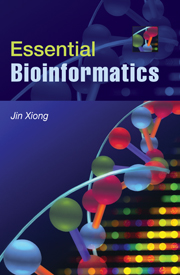Book contents
- Frontmatter
- Contents
- Preface
- SECTION I INTRODUCTION AND BIOLOGICAL DATABASES
- SECTION II SEQUENCE ALIGNMENT
- SECTION III GENE AND PROMOTER PREDICTION
- 8 Gene Prediction
- 9 Promoter and Regulatory Element Prediction
- SECTION IV MOLECULAR PHYLOGENETICS
- SECTION V STRUCTURAL BIOINFORMATICS
- SECTION V GENOMICS AND PROTEOMICS
- APPENDIX
- Index
- Plate section
- References
8 - Gene Prediction
Published online by Cambridge University Press: 05 June 2012
- Frontmatter
- Contents
- Preface
- SECTION I INTRODUCTION AND BIOLOGICAL DATABASES
- SECTION II SEQUENCE ALIGNMENT
- SECTION III GENE AND PROMOTER PREDICTION
- 8 Gene Prediction
- 9 Promoter and Regulatory Element Prediction
- SECTION IV MOLECULAR PHYLOGENETICS
- SECTION V STRUCTURAL BIOINFORMATICS
- SECTION V GENOMICS AND PROTEOMICS
- APPENDIX
- Index
- Plate section
- References
Summary
With the rapid accumulation of genomic sequence information, there is a pressing need to use computational approaches to accurately predict gene structure. Computational gene prediction is a prerequisite for detailed functional annotation of genes and genomes. The process includes detection of the location of open reading frames (ORFs) and delineation of the structures of introns as well as exons if the genes of interest are of eukaryotic origin. The ultimate goal is to describe all the genes computationally with near 100% accuracy. The ability to accurately predict genes can significantly reduce the amount of experimental verification work required.
However, this may still be a distant goal, particularly for eukaryotes, because many problems in computational gene prediction are still largely unsolved. Gene prediction, in fact, represents one of the most difficult problems in the field of pattern recognition. This is because coding regions normally do not have conserved motifs. Detecting coding potential of a genomic region has to rely on subtle features associated with genes that may be very difficult to detect.
Through decades of research and development, much progress has been made in prediction of prokaryotic genes. A number of gene prediction algorithms for prokaryotic genomes have been developed with varying degrees of success. Algorithms for eukarytotic gene prediction, however, are still yet to reach satisfactory results. This chapter describes a number of commonly used prediction algorithms, their theoretical basis, and limitations.
- Type
- Chapter
- Information
- Essential Bioinformatics , pp. 97 - 112Publisher: Cambridge University PressPrint publication year: 2006



